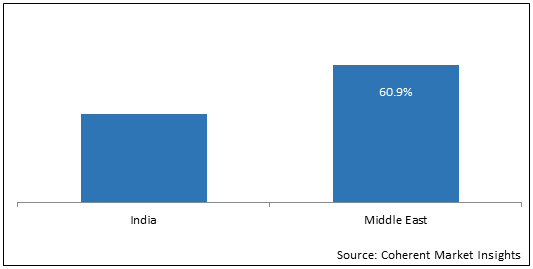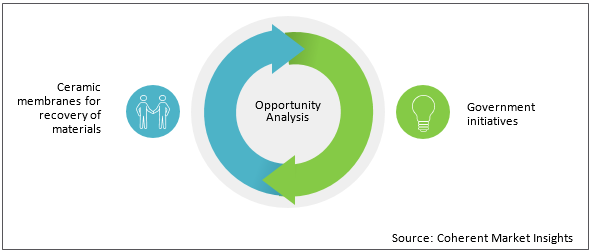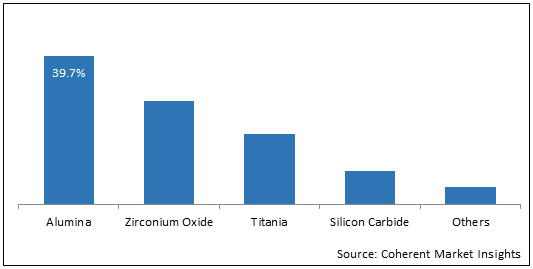Ceramic membranes are a type of artificial membranes and are used in membrane operations for liquid filtration. They can be used where aggressive media are present by contrast with polymeric membranes. Material types of ceramic membrane includes alumina, zirconium oxide, titania, and silicon carbide.
The India & Middle East ceramic membrane market is estimated to surpass US$ 1,687.20 million in terms of revenue by the end of 2028, exhibiting a CAGR of 10.20% during the forecast period (2021 to 2028).
Drivers
Increasing demand for treated water in India & Middle East has been augmenting the target market growth. Ceramic membranes are synthetic membranes made from inorganic constituents such as alumina, titania, silica, zirconia, and others. Ceramic membranes generally have an irregular structure with several porosity levels. Numerous pore sizes are offered for specific filtration requirements including microfiltration, ultra-filtration, and nano-filtration.
Growing requirement of high purity components for industrial applications is expected to foster the market growth of ceramic membrane. Augmented industrialization methods have given rise to a number of technologies such as microfiltration, ultrafiltration and nano-filtration, which uses ceramic membranes for separation. The group of porous membranes consisting of ceramic membranes are made with a well-defined pore size. Due to the high cost of ceramic membranes, manufacturers are focusing on developing newer membrane technologies and incorporating them into different applications. For instance, QUA, a key player in advanced membrane manufacturing products for the application of water and wastewater treatment, launched the CeraQ line of ceramic membrane modules, available in different sizes with surface area range. Moreover, in February 2017, Nanostone, a membrane solutions company, launched ‘CM-151’, its next generation membrane product.
Among India and Middle East, Middle East held dominant position in the India & Middle East ceramic membrane market in 2020, accounting for 60.9% market share in terms of revenue, followed by India.
Figure 1. India & Middle East Ceramic Membrane Market Revenue Share (%), By Region, 2020

To learn more about this report, Download Free Sample
Market Restraints
Cost involved in terms of initial capital investment and production of ceramic membranes is quite high compared to polymeric membranes when they are used for water treatment plants. Additionally, in environmental applications, the use of ceramic membranes has been limited due to cost considerations even though they offer various benefits in areas such as rugged structural stability, chemical, and thermal stability. These factors, together, are anticipated to hamper the India & Middle East ceramic membrane market growth.
Market Trends
Scarcity of water and waste reduction in Middle East is the current ceramic membrane market trend. Ceramic membranes manufactured from recycled locally-sourced materials could facilitate the cost-effective recycling of treated wastewater and help address water shortages in Middle East countries. This trend among industries is expected to further trigger demand for ceramic membranes from India & Middle East during the forecast period.
India & Middle East Ceramic Membrane Market Report Coverage
| Report Coverage | Details | ||
|---|---|---|---|
| Base Year: | 2020 | Market Size in 2020: | US$ 780.5 Mn |
| Historical Data for: | 2017 and 2020 | Forecast Period: | 2021 to 2028 |
| Forecast Period 2021 to 2028 CAGR: | 10.20% | 2028 Value Projection: | US$ 1,687.20 Mn |
| Geographies covered: |
|
||
| Segments covered: |
|
||
| Companies covered: |
Pall Corporation, Osmotech Membranes Pvt. Ltd., Hyflux Ltd., Jiangsu Jiuwu Hi-Tech Co. Ltd., CTI-Orelis, Saint-Gobain S.A., Aastropure Systems Pvt. Ltd., H & R Johnson (India), Aquabrane Water Technologies Pvt. Ltd., Aquatech International LLC, and Novasep |
||
| Growth Drivers: |
|
||
| Restraints & Challenges: |
|
||
Uncover macros and micros vetted on 75+ parameters: Get instant access to report
Figure 2. India & Middle East Ceramic Membrane Market – Opportunity Analysis

To learn more about this report, Download Free Sample
On the basis of material type, in 2020, alumina segment accounted for 39.7% of the revenue share. Alumina or aluminum oxide (Al2O3) in its various levels of purity is used more often than any other advanced ceramic material. Alumina-based ceramic membranes are mainly used in ultrafiltration and microfiltration technologies, and are generally available in pore sizes ranging from 70 – 1,000 nm.
Figure 3. India & Middle East Ceramic Membrane Market Revenue Share (%), By Material Type, 2020

To learn more about this report, Download Free Sample
India & Middle East Ceramic Membrane Market - Impact of Coronavirus (COVID-19) Pandemic
In case of construction materials, in certain cases, used ceramic membranes can be reprocessed as raw ceramic material to make new components or other products. This moderates the disposal cost and removes landfill concerns. Water & wastewater treatment uses ceramic membranes for oil-water separation, retention of micro-organisms, retention of heavy metals and radio-active substances, and purification of sewage water, among others. Pharmaceutical industries extensively use ceramic membranes to concentrate and purify enzymes, amino acids, vitamins and antibiotics, and fractionation of blood and plasma, among other applications of ceramic membranes.
Competitive Section
Key players operating in the India & Middle East ceramic membrane market include Pall Corporation, Osmotech Membranes Pvt. Ltd., Hyflux Ltd., Jiangsu Jiuwu Hi-Tech Co. Ltd., CTI-Orelis, Saint-Gobain S.A., Aastropure Systems Pvt. Ltd., H & R Johnson (India), Aquabrane Water Technologies Pvt. Ltd., Aquatech International LLC, and Novasep.
Share
Share
Missing comfort of reading report in your local language? Find your preferred language :
Transform your Strategy with Exclusive Trending Reports :
Frequently Asked Questions
Select a License Type
Joining thousands of companies around the world committed to making the Excellent Business Solutions.
View All Our Clients